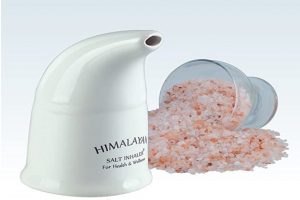Himalayan Salt Inhaler | What are the benefits of a Himalayan Salt Inhaler?
What is a Himalayan salt inhaler?
If you’re looking for a natural and effective way to support your respiratory health, a Himalayan salt inhaler might be just what you need. This simple yet powerful device uses the healing properties of pure Himalayan salt to help alleviate symptoms of respiratory conditions such as asthma, allergies, and chronic bronchitis. Not only does it improve respiratory health, but it also promotes overall wellness by helping to reduce stress and improve sleep quality. Himalayan salt is a natural anti-inflammatory and antibacterial agent that can help clear out your respiratory system and improve lung function. In this article, we’ll take a closer look at the benefits of using a Himalayan salt inhaler, how it works, and how you can incorporate it into your daily routine for better respiratory health.
Inhaling the salt is called ‘halotherapy’ – which is also known as salt therapy.
What is salt therapy?
Salt therapy, also known as halotherapy, is a complementary therapy that involves the inhalation or exposure to salt-infused air for potential health benefits. It is based on the belief that salt, particularly natural mineral-rich salt like Himalayan salt, has therapeutic properties.
The practice of salt therapy has roots in Eastern European salt mines and salt caves, where miners working in such environments were observed to have better respiratory health compared to the general population. This observation led to the development of dedicated salt therapy facilities and methods.
There are two primary forms of salt therapy:
- Dry Salt Therapy: In this form, individuals sit or lie in a specially designed room or chamber known as a salt room or salt cave. The walls and floors of these spaces are typically covered with salt, and a machine called a halogenerator crushes pharmaceutical-grade salt into tiny particles and disperses them into the air. Participants breathe in this salt-infused air while relaxing or engaging in deep breathing exercises.
- Wet Salt Therapy: Wet salt therapy involves direct contact with salt solutions, such as saltwater baths or saltwater nasal rinses. Saltwater solutions are typically made by dissolving salt in distilled water and used for nasal irrigation or as part of bathing rituals.
Proponents of salt therapy claim that it can provide various potential health benefits, including:
- Respiratory Health: Salt therapy is often used as a complementary approach to support respiratory conditions such as asthma, allergies, bronchitis, sinusitis, and COPD. It is believed to help clear mucus, reduce inflammation, and improve breathing.
- Skin Health: Salt therapy is sometimes used to address skin conditions like eczema, psoriasis, and acne. The salt particles in the air or saltwater solutions are thought to have antibacterial and exfoliating properties that can promote skin health.
- Relaxation and Well-being: Salt therapy sessions are often described as relaxing and stress-reducing, providing individuals with a calm environment to unwind and improve overall well-being.
While some people report positive experiences with salt therapy, it’s important to note that scientific evidence supporting its specific benefits is limited. Research on salt therapy is ongoing, and more studies are needed to fully understand its mechanisms of action and effectiveness.
If you are considering salt therapy, it’s recommended to consult with a healthcare professional to discuss your specific health needs and determine whether it is a suitable complement to your existing treatment plan.
What is halotherapy?
Halotherapy, also known as salt therapy, is a form of complementary therapy that involves exposure to salt-infused air or salt particles for potential health benefits. The term “halo” refers to salt in Greek, hence the name “halotherapy.”
During a halotherapy session, individuals typically spend time in a salt room, salt cave, or use a halogenerator, a device that disperses microscopic salt particles into the air. The salt particles are inhaled or come into contact with the skin, allowing for potential absorption or therapeutic effects.
Halotherapy is believed to have several potential benefits, although scientific evidence supporting these claims is limited. Some of the suggested benefits include:
- Respiratory Health: Halotherapy is often used as a complementary therapy for respiratory conditions such as asthma, allergies, bronchitis, sinusitis, and COPD. The salt particles are believed to have anti-inflammatory and antimicrobial properties that may help reduce airway inflammation, promote mucus clearance, and improve breathing.
- Skin Health: Halotherapy may be beneficial for certain skin conditions like eczema, psoriasis, acne, and dry skin. The salt particles are thought to have exfoliating and antimicrobial properties that could help improve skin health and reduce inflammation.
- Relaxation and Well-being: Halotherapy sessions are often described as relaxing and calming. The serene environment, combined with the perceived healing properties of salt, may contribute to stress reduction, relaxation, and a sense of well-being.
It’s important to note that the scientific evidence supporting the specific benefits of halotherapy is limited and mixed. Some studies suggest potential benefits, while others show no significant effects. More research is needed to fully understand the mechanisms of action and effectiveness of halotherapy.
If you are considering halotherapy, it’s advisable to consult with a healthcare professional, particularly if you have pre-existing respiratory or skin conditions. They can provide guidance based on your specific health needs and help determine whether halotherapy is a suitable complement to your existing treatment plan.
What are the benefits of using a Himalayan Salt Inhaler?
Because salt is a natural ingredient it may be able to benefit people who suffer from mild respiratory conditions. Its antibacterial properties can help prevent infections, act as an anti-inflammatory, and help keep airways clear by clearing up any build-up of mucus in your airways.
Research has been undertaken with published findings showing that halotherapy can be used to treat some respiratory conditions. These include:
- Lung infections
- COPD
- Breathing problems due to smoking
- Asthma
- Coughs and colds
- Rhinitis
- Tonsilitis
- Cystic Fibrosis

You should always seek professional medical advice for the treatment of respiratory illnesses. You should only use a salt inhaler as a supplemental device for the treatment and relief of respiratory conditions.
How can using a salt inhaler help?
Respiratory health: Inhaling salt particles can help to reduce inflammation in the respiratory system, making it easier to breathe. Think of things such as dirt, dust, and toxins which are all found naturally within our environment. This can be particularly beneficial for people with conditions such as asthma, allergies, bronchitis, and sinusitis.
Can help alleviate symptoms: Salt inhalers are a natural product, non-chemical and totally drug-free. Used regularly they can help alleviate symptoms.
Removes mucus and pollutants: Using a Himalayan salt inhaler allows the inhalation of salt crystals, through the airways toward the lungs. The antiseptic properties of the salt make the mucus thin with any pollutants and toxins then drawn to the surface.
Can improve breathing: Breathing is improved as the antiseptic properties of the salt help clear the sinus.
Improved sleep: Using a salt inhaler before bed can help to open up the airways and reduce snoring, leading to a more restful sleep.
Stress relief: It is known that salt therapy has a calming effect on the body. This can help reduce stress and anxiety.
Skin health: Salt therapy can also benefit the skin, helping to reduce inflammation and improve circulation.
Calms and de-stresses your mind and body: As the salt works by alleviating respiratory conditions, you may find that your body does not need to work as hard. This in turn will allow you to remain relaxed and calm.
Helps improve mood: Salt therapy can help improve one’s mood. It can you help you remain calm and help with de-stressing. It can also help improve breathing, and have a positive impact on your daily life.
How to use a Himalayan salt inhaler
How to use a salt inhaler – most salt inhalers come ready-filled – just unpack and use. Made to a very simple design with a mouthpiece and a chamber to place the salt, they are reusable. Also remember to only use Himalayan salts as they are 100% natural. Do not use any other type of salt in a salt inhaler as they contain anti-caking agents and anti-clumping agents.
Here’s the steps on how to use a salt inhaler:
Place the mouthpiece between your lips and breathe through your mouth. This will allow you to inhale the minute salt particles through your respiratory system and into your lungs. As the warm air flows through your system the moisture it creates absorbs the salt and creates a salt-like cave environment.
So to recap
- Place the mouthpiece between your lips and breathe in through your mouth
- Remember to breathe in through your mouth, and then exhale through your nose
- Repeat this process for about 10-15 minutes, several times a day
- When you have finished, remove the mouthpiece and clean the inhaler with a damp cloth
Conclusion
Salt inhalers are drug-free and are for use with mineral-rich salts – Himalayan pink salt. They are simple to use and easy to clean. Do not use a salt inhaler in place of professional medical treatment. They are a simple and natural way to help reduce some respiratory conditions. If you have a serious respiratory condition or any other health concerns, it’s always best to consult with a healthcare professional before using any new treatments.
More ideas
Do you still want to learn more? Then why not head over to our other sections to find out more about salt, its uses, other salt products, and some quick and easy recipes?
Table of Contents
- Himalayan Salt Inhaler | What are the benefits of a Himalayan Salt Inhaler?
- What is a Himalayan salt inhaler?
- What is salt therapy?
- What is halotherapy?
- What are the benefits of using a Himalayan Salt Inhaler?
- How can using a salt inhaler help?
- How to use a Himalayan salt inhaler
- Conclusion
- More ideas
